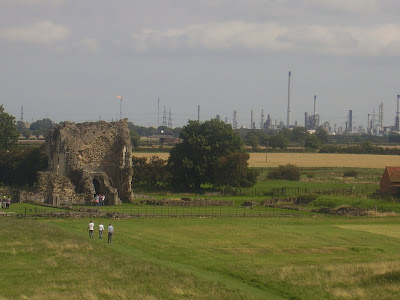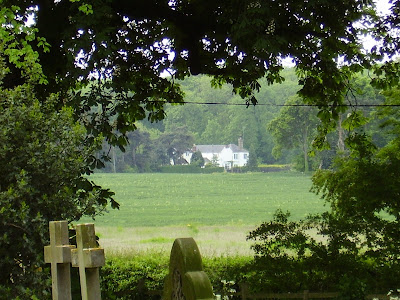
Sunday 31 August 2008
Friday 29 August 2008
Keeping the water out

 Back at work, and work has also started this week on the south aisle roof at St Michael’s, Little Coates. This is where repeated attacks on the church’s one lead covered roof made us decide to put slates there instead. All sorts of consultation and permission seeking had to go on before we could do so. Nevertheless the discovery yesterday was that the slates will raise the surface of the roof by enough to make it look as if rain water flowing down the slope might well over shoot the gutter. If this turns out to be the case, we may well find ourselves having to apply for permission to renew the guttering; this would obviously have to be wider yet in keeping, and would involve even more cost.
Back at work, and work has also started this week on the south aisle roof at St Michael’s, Little Coates. This is where repeated attacks on the church’s one lead covered roof made us decide to put slates there instead. All sorts of consultation and permission seeking had to go on before we could do so. Nevertheless the discovery yesterday was that the slates will raise the surface of the roof by enough to make it look as if rain water flowing down the slope might well over shoot the gutter. If this turns out to be the case, we may well find ourselves having to apply for permission to renew the guttering; this would obviously have to be wider yet in keeping, and would involve even more cost. Meanwhile, while I’ve been away, water has been getting into another part of the church where we thought earlier renewal of the roof had eliminated the problem. It appears that pigeon mess and nesting may have blocked a particularly inaccessible part of the roof drainage, so we hope a diligent eye here by the very generous person who goes up regularly to do the unpleasant clearing job along the valley gutter will prevent this happening again.
All this is just one part of a much larger story - the cost in anxiety, money and time is considerable for the small number of people who keep this sort of Grade I listed building attractive and open for the five thousand or so people we expect to see come through its doors in any given year. It has been said that the saving of great country houses was the great heritage achievement of the twentieth century but the saving of the whole range of village churches in particular will be the heritage challenge of the twenty-first century, and I can well believe this.
Thursday 28 August 2008
Holiday Heritage Studies

A purpose of the dissolution of the monasteries was to release money for ecclesiastical and educational reform. There was a even a scheme to create new smaller more effective dioceses with some former abbeys as Cathedrals, and some parts of the scheme were put into operation with the creation of dioceses like Chester and Peterborough which continue today. But, of course, most frequently personal profit won the day, and this is the version of history quite rightly best known.
I’m aware of this corner of history through the coincidence of having been educated at both a school and a University college founded in the 1540s. Both grew from initial efforts to redirect monastic wealth in the 1520s, both were then based on the property of dissolved monasteries, and both were lucky not to have been strangled soon after birth by those who wished to secure the endowments for themselves.
At the bottom of the tree, one of Henry VII’s Chaplains was working with a small brotherhood in his home town to seek to establish a school (and adding his own resources to the project) well before the dissolution released the whole of the brotherhood’s resources into the project; the new foundation nearly floundered after his death in the face of competing claims and was fortunate to secure a charter under Edward VI.
Meanwhile at the top of the tree, Cardinal Wolsey had the power to appropriate whatever he wished when he wanted to establish a school in his home town and a college in a University; the first did flounder after his fall, and the second was also suppressed along with a neighbouring new Cathedral foundation but was fortunate to be refounded by the King himself as a unique dual college and Cathedral foundation.
This all came to mind when we went to a recent Grimsby Civic Society lecture about Thornton Abbey near by, and heard about its refoundation in 1541 as a a collegiate church complete with Dean and staff, a model which only survives today in the two ‘royal peculiars’ of Westminster Abbey and St George’s Chapel, Windsor. The new foundation was quickly suppressed (two grand? too rich? too little obvious purpose?) and the first and only Dean died as Precentor of Lincoln Cathedral instead.
The English Heritage lecturer produced a print of this Dean’s seal, which he said had been recovered in the twentieth century from the Hull workbench to which it had been rivetted; it would be fascinating to know how it survived, how it came to be used in ths way, and how it was recognised and saved. The Abbey had been dedicated to Our Lady (and her crowned statue stands at the centre of the huge surviving gatehouse today) but the collegiate church was given the safer dedication of the Holy Trinity so the central picture of the seal is a picture of Father (crowned), Son (on the cross) and Holy Spirit (as a dove). The letters R D indicate the Dean Roger Dalyson.
We went to Thornton again this week, and the poor picture of the seal above is taken from one of the new display boards there. We also followed the lecturer’s tip and went to North Yorkshire for a tour of English Heritage’s northern archeological store and of the substantial remaining parts of near by Byland Abbey. Despoliation won much more often than reform.
Wednesday 27 August 2008
Tuesday 26 August 2008
Monday 25 August 2008
Another Holiday Bible Study

‘My purpose is to give them a rich and satisfying life’ simply isn’t the same as ‘I come that they may have life and have it abundantly’. It is rare that the reading at a service can make me sit bolt upright, but I did so at a service on holiday when I heard these words read as if they translated John10.10b.
On holiday abroad I would most often seek to worship in a local church, but on the Sunday in the middle of our holiday this year we worshipped with our hosts at a European Anglican Chaplaincy. The Chaplaincy had a definite tradition: the Chaplain conducted the service in a suit and preached in shirt sleeves (the transition from one to the other achieved by a deft wriggle of his shoulders as he prayed at the beginning of the sermon), the Baptism which was part of the service concluded with the giving of a Bible in place of the giving of a candle (which is legitimate, unlike leaving out the prayer over the water, which is what happened when I last attended a Baptism at a church of this tradition in the diocese of Lincoln), and the full Gafcon final statement was on a notice board in the hall. The service had all the best hallmarks of that tradition: sincere preaching, a genuine but not overwhelming welcome from several people, and a desire to experiment with a translation of scripture which might best be understood by an international community a large number of members of which did not have English as a first language.
It was the chosen translation which was new to me, although I find that the New Living Translation, which comes from an American Evangelical background, is in fact twelve year’s old. It may well be, as it claims, one of the most popular Bible translations in the English-speaking world, so I’m ashamed not to have been aware of it before.
The word translated ‘more plenteously’ by Wycliffe and ‘to the full’ by the New International Version is quite clearly the word for excess. It is used for abundance, superfluity, overflowing, and the sense of ‘too much’. A commentator suggests that here it indicates ‘a duration and quality beyond measure’. Elsewhere John uses a form of it to describe the large amount left over after the feeding of the five thousand.
The meaning is limited as soon as anyone tries to explain or unpack it. The choice of any two lesser words to do so doesn’t explain it but instead domesticates it. If the two words are ‘rich’ and ‘satisfying’ they also smuggle in connotations and values which are simply alien to its basic meaning. I cannot conceive why anyone should decide to translate it in this way. You might as well translate the Psalmist’s ‘my cup overflows’ as ‘God provides a varied and sufficient supply’. (Actually, I’ve looked this up, and it translates ‘my cup overflows with blessings’, the additional two words perhaps confirming that the translators can’t cope with poetry and feel free to add ideas of their own in a wide range of places.)
The vine was growing in one of our friend's hedges.
Sunday 24 August 2008
Holiday Bible Study
 ‘Jonah, who came out of the fish after three days, prefigures Christ who after three days left the sepulcher and rose form the dead’. So says a Latin caption in a fifteenth century bible picture book. And this is only the most obvious of a whole range of links between stories in the Old Testament and the Gospels which appear across pages and pages in such Biblia Pauperum (Bibles of the Poor). The parallels, prefigurings or ‘types’ would have been at the front of the mind of early and mediaeval Christians. It would have been a natural and prominent way of reading scripture.
‘Jonah, who came out of the fish after three days, prefigures Christ who after three days left the sepulcher and rose form the dead’. So says a Latin caption in a fifteenth century bible picture book. And this is only the most obvious of a whole range of links between stories in the Old Testament and the Gospels which appear across pages and pages in such Biblia Pauperum (Bibles of the Poor). The parallels, prefigurings or ‘types’ would have been at the front of the mind of early and mediaeval Christians. It would have been a natural and prominent way of reading scripture.The particular representation of the resurrection on a brass in St Nicolas’, Great Coates looks just like the picture in such books, which is what first took me to them. But having been taken to them, we keep finding the types represented everywhere. Buying a facsimile edition of a British Library Biblia Pauperum earlier this year has proved the most consistently useful and interesting purchase for a long time.
After Easter we went to Cambridge and spent a couple of hours in King’s College Chapel looking at the windows (having been prompted by Carola Hick’s new book The King's Glass). The whole scheme there reflects the types of the Biblia Pauperum. The sea monster disgorging Jonah in the resurrection window has a magnificent gleaming red eye with a huge green body curling away into the distance behind it.
This month we found him again on a tomb in the town church at Weimar; we enjoyed him so much that we chose him as the postcard to send to family and friends from the holiday (to the surprise of the man running the church bookstall who didn’t appear to have been asked for twenty-two copies of it before, and doubtless to the surprise of those receiving the postcards).
A neighbouring tomb had David carrying the head of Goliath which seems an unlikely representation of resurrection hope on a tomb until one goes back to the Biblia Pauperum and finds it is there a type of Jesus’ harrowing of hell.
The picture is of the town church in Jena rather than the one in Weimar because it was raining the day we were in Weimar.
Saturday 23 August 2008
Friday 22 August 2008
Thursday 21 August 2008
Wednesday 20 August 2008
Sunday 10 August 2008
Love in Cleethorpes
 I was involved in issuing four marriage licences last week. It used to be only one or two a year. The other clergyman authorised to do this locally also reports the same new pattern of requests.
I was involved in issuing four marriage licences last week. It used to be only one or two a year. The other clergyman authorised to do this locally also reports the same new pattern of requests.Most Church of England weddings don’t involve a licence at all. We retain the quaint sense that we all live in small communities and many people can’t read, so we go on giving notice by ‘publishing banns of marriage’ (reading out at worship on three Sundays the names of those to be married); it does have the nice side effect that we can invite those being married to worship with us in the church in which they are to be married. But applying for a licence is one of the possible alternatives. It is used especially where the banns process has been messed up, the couple want privacy, or the marriage involves a foreign national.
All four licences last week (and a good number over the last year) fall into this last category. The most common situation is the couple met soon after coming to work in the country a couple of years ago, live together in rented property in the terraces near the Football Ground on the edge of Cleethorpes, and work in catering somewhere in the resort, he being Egyptian or else eastern European and she being Lithuanian or else from a neighbouring country.
Those of us involved in these weddings one way or another have tried to understand the phenomenon. One wondered why so many Egyptian men are marrying eastern European women; my assumption is that few Egyptian women are working here and that couples from neighbouring countries and cultures are more likely to return home to be married. Another wondered whether we are being naive and in some cases visa manipulation might be a factor, but there doesn’t seem to be any advantage of this sort when marrying another foreign national, and we have no grounds to probe if the couples are legally entitled to be married.
I wondered myself how it is that some Moslems are willing to make vows in a Christian form; where one party is not Christian I do make clear to them that it is what the marriage would involve and they usually express surprise that I think it worth mentioning. Perhaps there is a phenomenon of cultural Islam as much as of cultural Christianity. In two cases in recent months the couple have already been through a form of Muslim marriage to meet the religious needs of one partner and now want a Christian form to meet the religious needs of the other quite as much as to establish a legal marriage.
The orchids are also on the Cleethorpes coast.
Friday 8 August 2008
Celebrating humanity
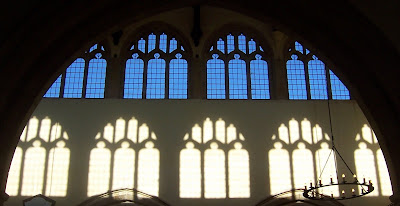 When it was reported that Solzhenitsyn had died, I was asked whether I had read anything of his. ‘Only One Day in the Life of Ivan Denisovich’, I replied, remembering his account of a typical prisoner’s day in one of Stalin’s labour camps, based on his own experience in the 1950s. ‘Ah, yes, at least the short book was available for those who couldn’t bring themselves to tackle the big ones’, discerned the totally accurate response.
When it was reported that Solzhenitsyn had died, I was asked whether I had read anything of his. ‘Only One Day in the Life of Ivan Denisovich’, I replied, remembering his account of a typical prisoner’s day in one of Stalin’s labour camps, based on his own experience in the 1950s. ‘Ah, yes, at least the short book was available for those who couldn’t bring themselves to tackle the big ones’, discerned the totally accurate response.What I took down from my shelf wasn’t Solzhenitsyn at all, but the poet Irina Ratushinskaya. I turn out not to have Grey is the Colour of Hope, her account of her own labour camp imprisonment in the 1980s, but only its prequel In the Beginning. Nevertheless, I remembered that in the earlier book she thanked Solzhenitsyn more than once for preparing her for this experience: above all Ivan Denisovich retained humanity by doing his forced labour tasks with care and by eating even the worst meals with manners; Ratushinskaya in turn refused all inducement to deny her own dignity and even regretted drafting a letter of complaint which included a slight distortion of the facts in her own favour.
Two other incidents stick in my mind. She wrote about clinging to the last hints of warmth in a heating pipe in the punishment cell knowing it would soon freeze, and somehow rejoicing in the beauty of frost on the window in the morning. She mentions someone queuing with her at the gate of a camp discovering she was a writer and asking whether she could write about where they were; I’m not clear why life is more livable when described, honoured and shared, but this person instinctively knew that it is as much as Solzhenitsyn and those who mourn him.
The poems she composed in the camp were written on soap and then memorised before being washed away. And magically I once very briefly handled one of the tiny scraps of writing which had then been smuggled out so that they could be published; she came to a national conference for Prison Chaplains in Lincoln, the organiser very kindly allowed me to attend the session, and she passed the examples round.
Wednesday 6 August 2008
Monday 4 August 2008
Awe and access
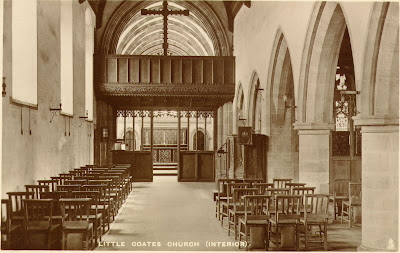
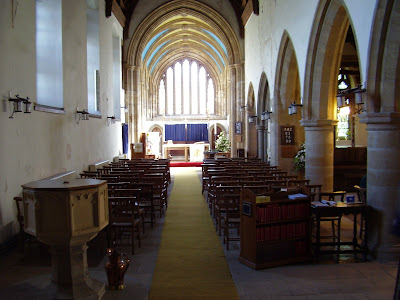 This weekend I’ve been gently taken to task for moving the chancel screen in St Michael’s. My kindly critic was someone who worshipped there forty years ago and who had only just visited the church again.
This weekend I’ve been gently taken to task for moving the chancel screen in St Michael’s. My kindly critic was someone who worshipped there forty years ago and who had only just visited the church again. The top picture shows St Michael’s as it was when this part of the church was consecrated in 1915. The lower one was taken from the same spot earlier this year, and captures the way in which light can flood the chancel rather than the nave. They don’t capture the intermediate stages: the cross and gallery on top of the screen were lost in the 1970s and a nave altar was placed in front it about then; for a generation the screen hasn’t looked like the top picture nor has the chancel been used much at all.
I’m sure the heritage bodies which consented to the recent moving of the remainder of the screen wouldn’t have done so if the cross and gallery had still been in place. I’m also sure they appreciated one of the aims which was to eliminate the nave altar and bring the architecturally distinguished chancel back into use.
Eliminating the nave altar has also allowed us to move people forward in the nave, thus creating space for the font at the back of the nave, and thus creating space for kitchen and toilet facilities at the back of the older part of the church where the font had stood. The chancel screen has not been lost but has been relocated to divide off this area at the back of the older part of the church.
For me the most interesting part of this weekend’s criticism is that it didn’t simply come from a ‘I like it as it was’ point of view. Rather my sympathetic critic understood very clearly what the original architect was seeking to achieve: for him the act of going up to Communion was to enter a very different sacred space, which can often have felt like passing through a barrier into the light; he observed how much more casual people appeared to be as they went up to Communion today compared with his own day.
For what it is worth, I’ve thought for a long time that there is an unresolvable tension in how a church is set out. It is a tension between the otherness of God and the intimacy which God offers, between awe at God’s majesty and being welcomed by God’s accessibility. The mediaeval sense of the ‘sacred space beyond the screen’ (consciously recreated by the architect in 1915) was to speak of the otherness of God. The bringing forward of altars at the Reformation was partly to speak of the accessibility of God. The moves in the seventeenth century to place the altar back behind rails (solid enough, it was said, to keep a dog out) were to reassert the sense of the majesty of God. Moves in the twentieth century such as the introduction of the nave altar in St Michael’s were to reassert the possibilities of intimacy with God.
It is as if any arrangement which provokes a sense of awe will appear to under value the humanity of Christ, and any arrangement which provokes a sense of welcome will appear to under value the divinity of Christ. It is my hope that the new arrangement in St Michael’s at least attempts to hold the tension by having the altar in the pool of light in the centre of the chancel but nevertheless has the chancel totally open. But I don’t think any church building can actually get it right.
Saturday 2 August 2008
Redundant St Matthew's
 The most prominent themes of this blog turn out to be closing churches and coping with a smaller numbers of people in too many open churches; this is the sixth of twenty-nine posts so far which focuses on them. So the discovery I make about myself is that 20% of my attention appears to be given to these themes.
The most prominent themes of this blog turn out to be closing churches and coping with a smaller numbers of people in too many open churches; this is the sixth of twenty-nine posts so far which focuses on them. So the discovery I make about myself is that 20% of my attention appears to be given to these themes.The picture is of St Matthew’s, Fairfield which has just officially became redundant. In the end it was the need to spend substantial amounts on the roof which prompted the move. At Easter most of the members of the remaining congregation moved ‘back’ to the ancient Scartho Parish Church which had originally established St Matthew’s as a ‘daughter church’. Yesterday the formal Church Commissioners scheme came into force bringing what had become two separate parishes back into one.
I’m told that in the 1960s the new Fairfield estate was overflowing with young families, and it was some distance south of Scartho Parish Church which had quite an old fashioned pattern of worship anyway. The mission strategy to establish a separate church where Family Worship flourished made a lot of sense, and many people are thankful that it was pursued for a generation of fruitful ministry. Forty years later the resources of the Church of England are more limited, the age profile of the estate is much older, Scartho itself has grown to the north as well to the south, and Scartho Parish Church is more obviously welcoming to families. The mission strategy to seek to serve the larger community well from one strong ancient church at its centre makes a lot of sense.
The bigger picture is this. If I had come to the area now covered by urban Grimsby and Cleethorpes 150 years ago I would have found five ancient Parish Churches. They are still clearly identifiable at Great Coates, Little Coates, Grimsby, Clee and Scartho, and nearly three hundred people will worship at regular services in them next Sunday. From the opening of St Peter’s, Cleethorpes in the 1860s to the opening of St Matthew’s, Fairfield in the 1970s a Bishop then came to dedicate a church on a new site twenty times; it was felt that every new housing area required a local church building.
But the Church of England vastly over stretched itself in doing this, and now half the twenty new churches have been disused and, in most cases, demolished. A St Barnabas’ church shut as long ago as the 1950s and now St Matthew’s is the tenth of them to do so. Nevertheless, this all means that we still have fifteen open churches; we have one for every 8000 or so people, and we have more open Anglican churches than the thirteen churches the Baptists, Catholics, Methodists and United Reformed Church have open between them. Actually, with a range of small independent congregations as well, up to two thousand Christian people may be meeting for worship in nearly forty different buildings next Sunday.
Subscribe to:
Posts (Atom)






